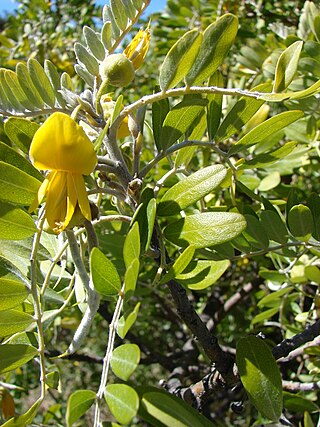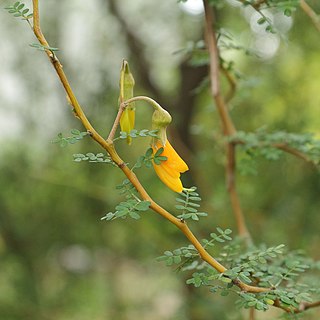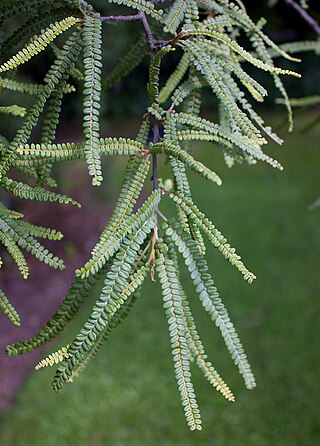
Kōwhai are small woody legume trees within the genus Sophora in the family Fabaceae that are native to New Zealand. There are eight species, with Sophora microphylla and S. tetraptera being the most recognised as large trees. Their natural habitat is beside streams and on the edges of forest, in lowland or mountain open areas. Kōwhai trees grow throughout the country and are a common feature in New Zealand gardens. Outside of New Zealand, kōwhai tend to be restricted to mild temperate maritime climates.

Sophora is a genus of about 45 species of small trees and shrubs in the pea family Fabaceae. The species have a pantropical distribution. The generic name is derived from sophera, an Arabic name for a pea-flowered tree.

Sophora toromiro, commonly known as toromiro, is a species of flowering tree in the legume family, Fabaceae, that is endemic to Easter Island.

Dermatophyllum secundiflorum is a species of flowering shrub or small tree in the family Fabaceae that is native to the Southwestern United States and Mexico. Its common names include Texas mountain laurel, Texas mescalbean, frijolito, and frijolillo.

Cytisine, also known as baptitoxine, cytisinicline, or sophorine, is an alkaloid that occurs naturally in several plant genera, such as Laburnum and Cytisus of the family Fabaceae. It has been used medically to help with smoking cessation. Although widely used for smoking cessation in Eastern Europe, cytisine remains relatively unknown beyond it. However, it has been found effective in several randomized clinical trials, including some in the United States and a large one in New Zealand, and is being investigated in additional trials in the United States and a non-inferiority trial in Australia in which it is being compared head-to-head with the smoking cessation aid varenicline. It has also been used entheogenically via mescalbeans by some Native American groups, historically in the Rio Grande Valley predating even peyote.

Sophora chrysophylla, known as māmane in Hawaiian, is a species of flowering plant in the pea and bean family, Fabaceae, that is endemic to Hawaii. It is highly polymorphic, growing as a shrub or tree, and able to reach a height of 15 m (49 ft) in tree form. Yellow flowers are produced in winter and spring.
Gennady Pavlovich Yakovlev Russian botanist, pharmacognosist, phytochemist. Former director of Saint-Petersburg State Chemical-Pharmaceutical Academy (1992–2004). Expert in Fabaceae taxonomy.

Sophora cassioides is a legume tree native to Chile.

Styphnolobium japonicum, the Japanese pagoda tree is a species of tree in the subfamily Faboideae of the pea family Fabaceae.

Sophora flavescens, the shrubby sophora, is a species of plant in the genus Sophora of the family Fabaceae. This genus contains about 52 species, nineteen varieties, and seven forms that are widely distributed in Asia, Oceania, and the Pacific islands. About fifteen of these species have a long history of use in traditional Chinese medicines.

Sophora tetraptera, commonly known as large-leaved kōwhai, grows naturally only in the central east of the North Island in New Zealand. S. tetraptera has larger more widely spaced leaves than the other seven species of kōwhai.

Matrine is an alkaloid found in plants from the genus Sophora. It has a variety of pharmacological effects, including anti-cancer effects, as well as κ-opioid and μ-opioid receptor agonism.

Uresiphita polygonalis is a moth of the family Crambidae. The species was described by Michael Denis and Ignaz Schiffermüller in 1775. It is found in the Pacific, including Hawaii and New Zealand, Sri Lanka, Europe and northern and southern Africa.

Sophora tomentosa, also known as necklacepod, yellow necklacepod, and occasionally as silver bush, is a pantropical shrub or small tree in the family Fabaceae. It commonly ranges in height from 4 to 10 feet and often occurs in coastal conditions and near wetlands. The common name Necklacepod is derived from the characteristic string of seed pods that develop after its yellow flowers germinate into seeds.

Sophora prostrata is commonly known as kōwhai, prostrate kōwhai or dwarf kōwhai and is endemic to the eastern South Island from Marlborough to the Waitaki Valley in New Zealand although most commonly found on the Banks Peninsula.

Sophora godleyi, also known as Godley's kōwhai, papa kōwhai or Rangitikei kōwhai, grows naturally in the west of the North Island of New Zealand from Te Kuiti to Manawatu. It is one of eight recognised species of kōwhai and was described as a separate species in 2001, having formerly been considered to be part of species small-leaved kōwhai. It is named after Dr. Eric Godley, former head of the Department of Scientific and Industrial Research (DSIR) Botany Division.

Sophora molloyi, the Cook Strait kōwhai, Molloy's kōwhai or Stephen's Island kōwhai, is one of 8 species of kōwhai native to New Zealand, and grows naturally around the Cook Strait region. It was first described as a species in 2001 and named after Brian Molloy of Landcare Research, who was a researcher and scientist there for more than 30 years.

4′,7-Dihydroxyflavone is a flavone. It is found in Medicago truncatula in relation with the root nodulation symbiont Sinorhizobium meliloti or in seeds of Sophora viciifolia.

Sophora fulvida, the kōwhai or west coast kōwhai is one of 8 species of native Sophora or kōwhai in New Zealand and grows naturally around the Northland, Auckland and Waikato regions of New Zealand.

Sophora chathamica, the coastal kōwhai, sometimes known as Chatham Island kōwhai, is one of 8 species of native sophora or kōwhai in New Zealand and grows naturally in the north-west of the North Island in New Zealand, as far south as the Tongaporutu River in north Taranaki, and as far north as Te Paki. It can also be found growing near Wellington and the Chatham Islands, although these later plantings are thought to be a result of Māori plantings in the late 18th century and early 19th century. Prior to 2001, it was included as variant of Sophora microphylla, therefore references to either Sophora microphylla var. chathamica or Sophora microphylla subsp. microphylla var. chathamica are considered references to coastal kowhai.


















